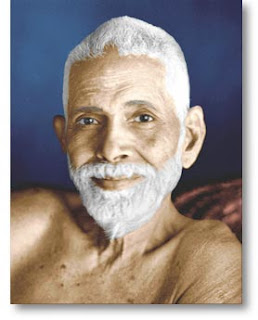With
the previous post, Dakshinamurthy stotram or Ashtakam (8 verses) actually ends.
The
remaining two verses are ancillary to the text. The first aims to assist the
Sadhaka to raise his level of eligibility for the Ashtakam; and the second tells us about the fruit of studying the Ashtakam.
Verse 9

Earth,
water, fire, air, space, sun, moon and man, (the individual soul),
Thus,
shining everywhere are the movable and immovable (sentient and inert) objects
of His Eightfold Manifestation,
Other than this, there exists nothing else, to those who reflect well. From that One Supreme Cause arise all manifestations,
To
that “Supreme Cause”, the Revered Form of the Guru, do I offer my salutation.
He is the Revered Form of Sri Dakshinamurti!
The
usual technique of Upasana is
prescribed for those diligent students who, even after a deep and careful study
of the Ashtakam (verses 1-8), are not
able to appreciate the import of them all.
Lack
of integration within will make students unfit for such subtle flights to the
lofty heights of Vedanta when it discusses the ultimate theme. To help them
gain the necessary integration, this stanza prescribes an Upasana.”
The
“Ashta Murti” Upasana to Develop Bhakti
The
5 elements of the universe are also the constituents of the body.
The
sun and the moon are the two eyes.
As
Eswara rules the external world, so
too, the Jiva rules the inner world. Thus, all the eight components listed in
the verse are seen within the body.
The
Upasaka feels that whatever is done by the body is worship of Eswara.
A saint says, “A saint who used to feel that
when he slept, he was prostrating to the Lord; when he bathed, he was bathing
the Lord; when he ate, he was feeding the Lord. In this way, he took his whole
body to be the temple of God. Such practices enrich Indian culture and
spirituality.
They take the practice of religion to the
highest pedestal. There is no superstition in such practices. They arise from a
sincere love for the Lord, and a strong desire to please Him and serve Him in every
way possible.”
We
have come across this eightfold manifestation of the Lord’s material nature in
Sri Ramana Maharshi’s Upadesa Saram, where it is used for the same purpose – as
an Upasana to broaden the devotion of
the Bhakta.
The
same is enumerated here as the five elements, sun, moon and the Jiva
(man/individual soul).
Aharnaatha: This means “God of the Day”; it stands here
for the sun.
Himaanshu: This means “having cool rays”; it stands here
for the moon.
Pumaan: is the individual soul or Jeeva, the living being, that is bound in Samsara.
All
movable and immovable objects are covered by these 8 items.
A
verse in Ganapati Atharva Upanishad says,
You
(Eswara) are earth, water, fire, air and space.
Typically,
five elements are enough to represent God of the Cosmos. However, poetic
representations usually include the Sun and the Moon.
So this representation gives you that vision of Eswara having not just five elements but the Sun and the Moon. It poetically represents the cosmic perspective.
The universe is also a conscious, intelligent living thing. So, the Consciousness is the eight element presented here with the word Puman, which is the man or individual soul or consciousness.
The
8-fold manifestation is a simplification of 36 components given below.
5 elements,
5 Pranas,
5 Karma Indriyas,
5 Jnana Indriyas,
4-fold Antahkarana,
Jeeva,
Time,
Prakriti,
Maya,
Vidya,
Purusha,
Bindu,
Nada,
Shakti,
Shiva,
Shanta and
Ateet.
Everything
in this Cosmos is included in the eight-fold representation. There is nothing
left out. So, this is absolute, fully encompassing expression.
Brahman
All
that exists is Brahman, is the
reality because of which material things exists.
Brahman is also the reality
because of which Consciousness itself exists.
Even
experience exists due to Brahman. So,
Brahman manifests not only as
material inert things, but manifests as sentient things and sentiency
itself, Consciousness itself, experience itself. Other than that Brahman, supreme all pervasive being,
nothing else exists.
This
is a poetic way stating the same fact that ancient rishis declared,
Continued…
Love.












